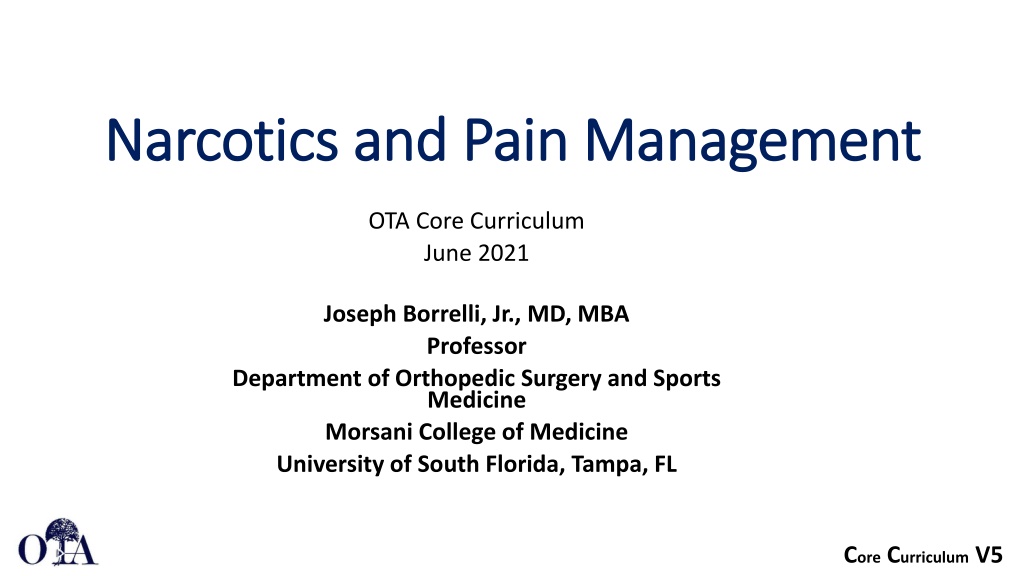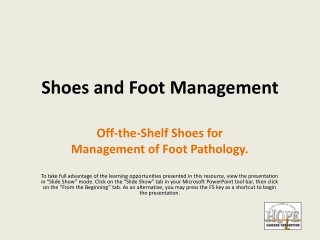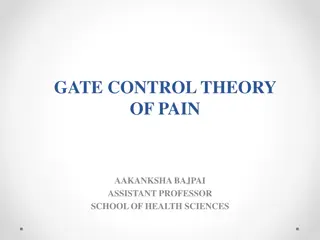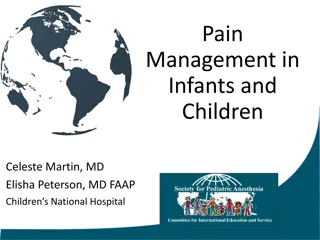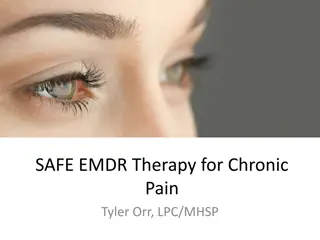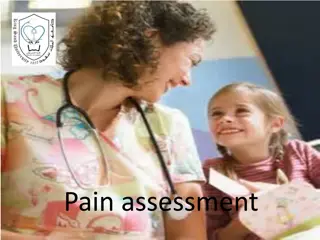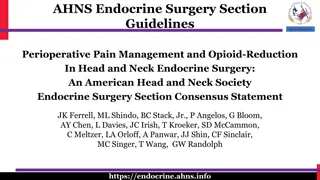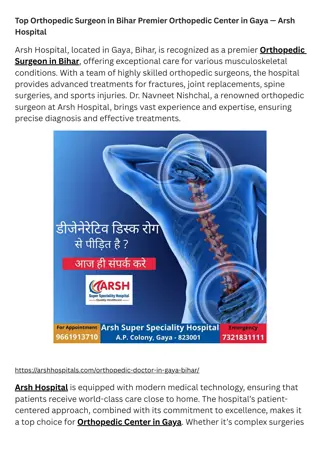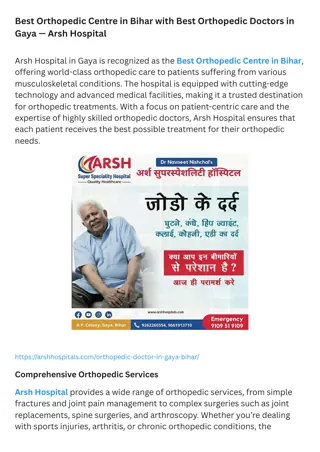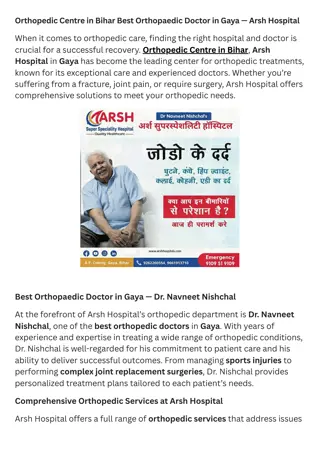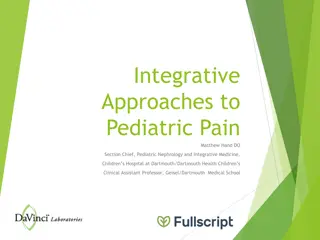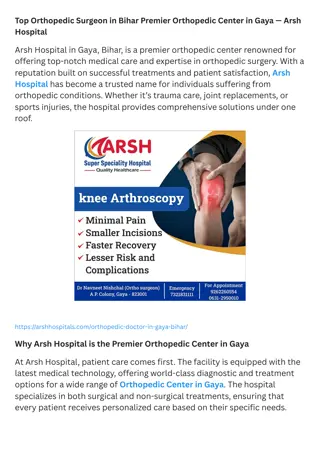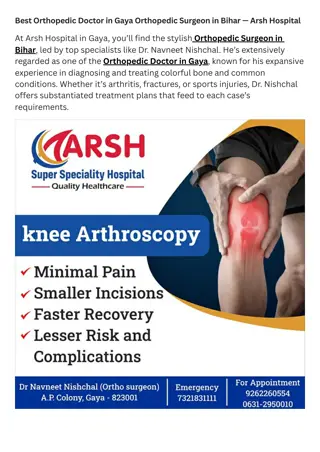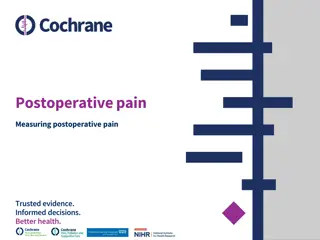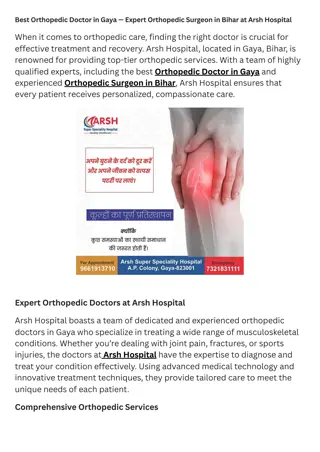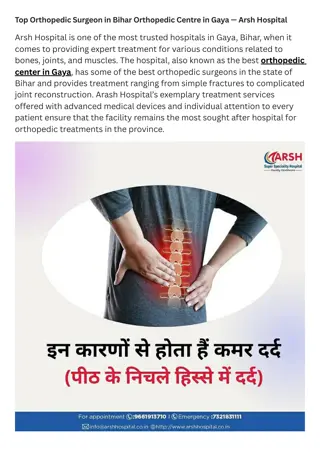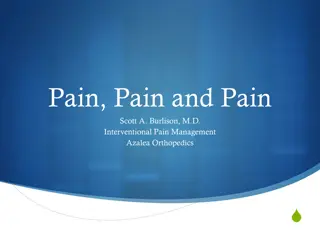Pain Management in Orthopedic Surgery
Pain management in orthopedic surgery involves reviewing pain pathways, mitigating pain transmission, understanding pain medications, and implementing multi-modal pain relief strategies. Pain is a complex and subjective experience with sensory, affective, emotional, and cognitive dimensions. Factors such as pain threshold and perceptual dominance play a role in pain perception and management.
Download Presentation

Please find below an Image/Link to download the presentation.
The content on the website is provided AS IS for your information and personal use only. It may not be sold, licensed, or shared on other websites without obtaining consent from the author.If you encounter any issues during the download, it is possible that the publisher has removed the file from their server.
You are allowed to download the files provided on this website for personal or commercial use, subject to the condition that they are used lawfully. All files are the property of their respective owners.
The content on the website is provided AS IS for your information and personal use only. It may not be sold, licensed, or shared on other websites without obtaining consent from the author.
E N D
Presentation Transcript
Narcotics and Pain Management Narcotics and Pain Management OTA Core Curriculum June 2021 Joseph Borrelli, Jr., MD, MBA Professor Department of Orthopedic Surgery and Sports Medicine Morsani College of Medicine University of South Florida, Tampa, FL Core Curriculum V5
Objectives Objectives Review pain pathways within the human body Review means by which pain transmission is mitigated Review variety of different classes of pain medications and their mechanism of action Review benefits and rationale for multi-modal pain relief in orthopedic surgery Core Curriculum V5
Introduction: Pain Introduction: Pain Definition: Unpleasant sensory and emotional experience associated with, or resembling that associated with, actual or potential tissue damage International Association for the Study of Pain Core Curriculum V5
Introduction: Pain Introduction: Pain Difficult to define!! Pain is a unique subjective experience of an individual Physiological protective system Essential to warn, detect, and minimize contact with damaging stimuli Core Curriculum V5
Introduction: Pain Introduction: Pain Dimensions of pain: Sensory/discriminative Intensity Perception of sensory input Quality, quantity and geographic area Affective/motivational Unpleasantness Emotional/behavioral aspects of the pain experience Cognitive/evaluative Thoughts How much pain an individual feels can depend upon past experiences Modulation by central and peripheral nervous system can dampen or augment pain perception Core Curriculum V5
Introduction: Pain Introduction: Pain Pain Threshold the point at which any stimulus is felt as pain Similar pain threshold among healthy people Remains the same in the same person over time Adults have a higher pain threshold than children b/w 15-18 y/o Aging increases the pain threshold and may be due to changes in the skin thickness or the presence of peripheral neuropathies Perceptual dominance the increase in the pain threshold at one point (part of the body) due to severe pain in another point (part of body) Core Curriculum V5
Introduction: Pain Introduction: Pain Pain Tolerance the intensity of pain that an individual will tolerate before any visible responses Varies amongst people and in the same person over time Affected by cultural background, physical and mental health, expectations and role behaviors Tolerance is decreased with repeated pain, anger, fatigue, fear and sleep deprivation Tolerance is increased by drugs, alcohol consumption, distraction, hypnosis and strong beliefs or faith Core Curriculum V5
Introduction: Pain Introduction: Pain Pain Classification Nociceptive pain Sensing of noxious stimuli Protective role requiring immediate attention and responses Inflammatory pain Important to promote healing and protection of injured tissues. Increases sensory sensitivity through pain hypersensitivity and tenderness. Caused by activation of the immune system that causes inflammation after tissue injury or infection Pathological pain Maladaptive response - results from abnormal functioning of the nervous system Amplified sensory signals in the central nervous system Fibromyalgia, irritable bowel syndrome, tension-type headache, temporomandibular joint disease Core Curriculum V5
Introduction: Pain Introduction: Pain Pain Classification Acute pain Caused by noxious stimuli and is mediated by nociception Early onset and serves to prevent tissue damage Chronic pain Pain continuing beyond 3 months, or after healing is complete May arise as a consequence of tissue damage or inflammation or have no identified cause Complex condition embracing physical, social and psychological factors Core Curriculum V5
General Pain Pathway General Pain Pathway 4 major processes for pain to be perceived 1. Transduction tissue damaging stimuli activate nociceptor (pain receptor) nerve endings 2. Transmission relay function carrying the impulse to the brain regions 3. Modulation neural process to reduce activity of the transmission system 4. Perception subjective awareness of the sensory signals Core Curriculum V5
General Pain Pathway General Pain Pathway Types of tissue damage perceived as stimuli Thermal Mechanical Chemical Core Curriculum V5
General Pain Pathway General Pain Pathway - - Transduction Transduction Tissue injury releases potassium, serotonin, histamine, prostaglandins, substance P and bradykinin from damaged vessels These activate the sensory afferent nociceptor fibers which release prostaglandins which sensitizes nociceptors and leads to primary hyperalgesia Orthodromic transmission in sensitized afferents result in the release of substance P (sP) in and around the site of injury. Substance P is responsible for further release of bradykinin. Substance P also stimulates release of histamine from mast cells and serotonin from platelets, which in turn activates additional nociceptors and exacerbates the inflammatory response. Reflexes mediated by sympathetic efferents may sensitize nociceptors directly through secretions of norepinephrine (NE), indirectly through further release of bradykinin and prostaglandin, or by localized vasoconstriction. Fields HL: Pain. New York: McGraw-Hill, 1987, p 36. Core Curriculum V5
General Pain Pathway - Transmission Nociceptors are the first order sensory pain fibers synapsing with the secondary nerve fibers at the Dorsal Root ganglion First order neuron has cell body in dorsal root ganglion and long axon to periphery and short one to spinal column A second order fibers transmit the impulse through the anterolateral quadrant of the spinal cord to the brain stem, thalamus and somatosensory cortex Core Curriculum V5
General Pain Pathway General Pain Pathway - - Transmission Transmission The dorsal horn is divided into discrete laminae based upon the tendency of different types of afferent fibers to synapse at specific laminae or depths. Descending input from higher centers (higher spinal cord, midbrain, and cerebral cortex) can modulate this transmission Core Curriculum V5
General Pain Pathway General Pain Pathway - - Transmission Transmission Pain Transmission The delta fibers and C fibers innervate both skin and internal organs, including the periosteum, joints, viscera and muscles Terminate as free peripheral nerve endings = nociceptors Delta fibers are myelinated, typically transmit more quickly and give sensation of immediate pain and are well localized C fibers are unmyelinated, have a slower conduction velocity and could be termed polymodal because a single C fiber may respond to a variety of noxious stimuli and mediate the perception of after pain These nociceptive afferent fibers synapse at the spinal cord dorsal horn, where processing and modulation take place before further transmission Core Curriculum V5
Processes that Enhance Pain Processes that Enhance Pain Sensitization repeated stimuli threshold for afferent nociceptors decrease leading to lower pain threshold Hyperactivity Sympathetic Nervous System Muscle contraction a result of nociceptor activity as primitive withdrawal effect Self- sustaining Painful processes Livingston Vicious Circle painful processes set in motion secondary processes not associated with tissue damage that cause a spread of the nociceptive input leading to chronic pain Neuropathic pain pain from nerve damage e.g. causalgia Core Curriculum V5
General Pain Pathway General Pain Pathway - - Modulation Modulation Can occur by stimulation produced analgesia electrical stimulation from various brain regions can block pain (midbrain to medulla) Analgesia Endogenous opioid peptides in brain stem will suppress pain (endorphins) Exogenous opioids also act here Core Curriculum V5
General Pain Pathway General Pain Pathway - - Modulation Modulation Natural occurring OPIOID RECEPTORS Mu morphine receptors Houde/Wallenstein 1956, Lasagna/Beecher 1954 Delta based upon enkephalins proposed by Kosterlitz (Lord et al. 1977) Kappa pharmacology of ketocyclazocine Martin et al . 1976 Cannabinoid receptors in brain and spinal cord Each of these receptors are G1 protein coupled receptors and their activation leads to a reduction in neurotransmitter release through inhibition of AC/cAMP and cell hyperpolarization reducing cell excitability Core Curriculum V5
Pain Mitigation Pain Mitigation Exogenous OPIOIDS Morphine and its many derivative Cannabinoids modulates neurotransmiter release Endogenous Opioid peptides - opioids B-endorphins Dynorphins Enkephalins Morphine C17H19NO3 Opioids regulate pain at spinal cord, brain stem, and cerebral cortex by reducing neuro transmitter from first order neurons Core Curriculum V5
Pain Mitigation: Analgesic Classes: Pain Mitigation: Analgesic Classes: Non Non- -endogenous Opioids endogenous Opioids Two types of non endogenous opioids Natural Opioids those derived from the poppy plant; Parent compound = OPIUM Morphine, codeine, thebaine Semi-Synthetic and Synthetic Opioids Create an altered chemical structure to have morphine like analgesia with potential far greater potency but with decreased the number and degree of untoward side effects Respiratory depression, constipation, drowsiness, etc Core Curriculum V5
Pain Mitigation: Analgesic Classes: Pain Mitigation: Analgesic Classes: Non Non- -endogenous Opioids endogenous Opioids Semi-Synthetic Opioids synthesized using chemical methods with natural opiate as a substrate; Heroin and hydromorphone (dilaudid) Hydrocodone from codeine Oxycodone from thebaine Synthetic Opioids synthesized completely in the lab with a natural opioid substrate; Fentanyl, tramadol Core Curriculum V5
Pain Mitigation: Analgesic Classes: Pain Mitigation: Analgesic Classes: Non Non- -endogenous Opioids endogenous Opioids Opioid Type Characteristics Morphine natural Analgesic, metabolically active, neuroexcitable, metabolites can cause seizures Codeine Natural Metabolized by liver to morphine, 7% Caucasians cannot do this, no effect Hydrocodone Semisynthetic Metabolized to hydromorphone Oxycodone Semisynthetic Metabolized to oxymorphone, may effect potency of fluoxetine, atorvastatin, erythromycin Hydromorphone Semisynthetic Metabolically active. neuroexcitatory Fentanyl Synthetic Metabolized by liver, , may effect potency of fluoxetine, atorvastatin, erythromycin Tramadol Synthetic Metabolized to O-desmethyltramadol(M1), inhibits serotonin and norepinephrine reuptake to cause analgesia Hagedorn JC, Danilevich M, Gary JL. JAAOS, 2019;27:e831-e837. Core Curriculum V5
Opioid Receptors Opioid Receptors G protein-coupled receptors with opioids as ligands in brain and spinal cord and peripheral neurons Mu opioid receptors induce relaxation, trust and strong analgesia Kappa suppress mu-opioid effect while deltoid induce impulsivity The up and down regulation of the 3 receptors may account for psychiatric disorder fluctuations Core Curriculum V5
Opioid Receptors: Physiological Effects Opioid Receptors: Physiological Effects Mu ( ) - supraspinal and spinal analgesia; sedation; inhibition of respiration; slowed GI transit; modulation of hormones and neurotransmitter release; euphoria Delta (?) supraspinal and spinal analgesia; modulation of hormone and neuro transmitter release Kappa ( ) - supraspinal and spinal psychomimetic effects; slowed GI transit; dysphoria Core Curriculum V5
Opioid Antagonist and Partial Agonists Opioid Antagonist and Partial Agonists Naloxone (Narcan) antagonist of MOR, KOR, and DOR Competitor inhibitor of opioids, reverses opioids by blocking MOR and preventing the euphoria associated with opioids Pure MOR antagonist Buprenorphine partial agonist, activates the opioid receptors to a lesser degree than morphine, outcompetes morphine for the MOR receptor causes decreased overall opioid stimulus leading to a lower peak effect Core Curriculum V5
Pain Mitigation: Analgesic Classes: Pain Mitigation: Analgesic Classes: Non Non Opioids Medications Opioids Medications NSAIDs Block formation of thromoboxane and prostaglandins by blocking Cox-1 and Cox-2 enzymes (cyclooxygenase-1) By doing so NSAIDs mitigate surgical and traumatic pain by directly blocking pain transmission and reducing local inflammation and additional tissue damage decreases the nociceptive stimulus Celecoxib only selective COX-2 inhibitor Increased risk of thrombosis, stroke and heart attack Core Curriculum V5
Pain Mitigation: Analgesic Classes: Pain Mitigation: Analgesic Classes: Non Non Opioids Medications Opioids Medications Acetaminophen Acts on COX-2 enzyme centrally with little anti- inflammatory effect May block COX-3 found in CNS Activates the serotonergic pathways potentiating pain modulation Affects endogenous cannabinoid and vanilloid system through AM404 to decrease pain transmission and decrease body temperature Core Curriculum V5
Oral Morphine Equivalents (OME) Oral Morphine Equivalents (OME) Narcotic Codeine Hydrocodone Hydromorphone (Dilaudid) Morphine Oxycodone Tramadol Fentanyl transdermal (mcg/hr) OME 0.15 1 4 1 1.5 0.1 2.4 Core Curriculum V5
Pain Mitigation: Analgesic Classes: Pain Mitigation: Analgesic Classes: Non Non- -endogenous Opioids endogenous Opioids Gabapentinoids (gabapentin/pregabalin) Analog of neurotransmitter (GABA) Affects a voltage-gated calcium channel that reduces neurotransmitter release and decreases post-synaptic excitability and therefore decrease neuropathic pain Predominant effect in the dorsal horn of spinal cord Not capable of being sole modality for acute surgical pain Controversial use to decrease pain in acute postoperative setting Core Curriculum V5
Multi Multi- -Modal Pain Relief Modal Pain Relief Pain has many dimensions and so no single drug or technique is sufficient to provide complete/near complete pain relief without side effects Therefore, drugs and techniques should be used in combination to maximize the beneficial effects of combination therapy while minimizing the side effects of an individual approach. Multimodal analgesia is a combination of two or more analgesics with a different mode of action, designed to improve analgesia and decrease side effects through reduction in analgesic dose, particularly opioids. Core Curriculum V5
American Pain Society Multi American Pain Society Multi- -Modal Pain Relief Modal Pain Relief >80% of patients who undergo surgical procedures experience acute postoperative pain, ~ 75% of those with postoperative pain report the severity as either moderate, severe or extreme! <50% of the patients who undergo surgery report adequate postoperative pain relief, Inadequately controlled pain negatively affects quality-of-life, function and functional recovery, the risk of postsurgical complications and the risks of persistent postsurgical pain, Core Curriculum V5
American Pain Society Multi American Pain Society Multi- -Modal Pain Relief Modal Pain Relief The American Pain Society (APS), with input from the American Society of Anesthesiologists (ASA), commissioned a guideline on management of postoperative pain to promote evidence based, effective, and safe postoperative pain management in adults Core Curriculum V5
American Pain Society Multi American Pain Society Multi- -Modal Pain Relief Modal Pain Relief The panel recommends that clinicians offer multi-modal analgesia, or the use of a variety of analgesic medications and techniques combined with non- pharmacological interventions for the treatment of postoperative pain in children and adults, (strong recommendation, high quality evidence) Multi-modal analgesia, defined as the use of a variety of analgesic medication techniques that target different mechanisms of action in the peripheral and/or central nervous system have an additive or synergistic effect and are more effective pain relief compared with single drug interventions Clinicians might offer local anesthetic base regional analgesic techniques, systemic opioids and other analgesics Core Curriculum V5
Long term analgesic use after low risk surgery Long term analgesic use after low risk surgery If get opioid prescription within 7 days of surgery had 44% chance of on long term opioids over those with no prescription If started taking NSAIDs within 7 days of surgery were 4 times more likely to become long term NSAID users compared to those with prescription Alam A, Arch intern Med 2012; 172(5): 425 - 430 Core Curriculum V5
American Pain Society Multi American Pain Society Multi- -Modal Pain Relief Modal Pain Relief Selection of multi-modal therapies is a challenge because for each surgical procedure, many potential multi-modal therapy combinations are possible When using multimodal analgesia, clinicians should be aware of the different side effect profile for each analgesic medication or technique used, and provide appropriate monitoring to identify and manage adverse events, Examples of Recommended multi-modal therapies: Chou R, Gordon DB, de Leon-Casasola OA, et al. Guidelines on the Management of Postoperative Pain. The Journal of Pain, Vol. 17, No. 2 (February) 2016: pp 131-157. Core Curriculum V5
Multi Modal for Common Orthopaedic Surgical Procedures Type of Surgery Systemic Pharmacologic Local, Intraarticular Regional Neuraxial Anesthetic Nonpharmacologic Total hip Opioids, NSAIDs and or acetaminophen, gabapentin, pregabalin, i.v. ketamine Intra articular local and/or opioid Site specific with local Epidural with local with/or with opioid or intrathecal opioid Cognitive modalities, TENS Total Knee Opioids, NSAIDs and or acetaminophen, gabapentin, pregabalin, i.v. ketamine Intra articular local and/or opioid Site specific with local Epidural with local with/or with opioid or intrathecal opioid Cognitive modalities, TENS Spinal Fusion Opioids, NSAIDs and or acetaminophen, gabapentin, pregabalin, i.v. ketamine Intra articular local and/or opioid Epidural with local with/or with opioid or intrathecal opioid Cognitive modalities, TENS Core Curriculum V5
Regional Anesthetic Techniques Regional Anesthetic Techniques From 11 randomized and quasi randomized trials with 1062 patients showed the fascia iliaca compartment block was superior to opioids for preoperative analgesia for hip fracture patients High block success rate with few adverse effects Faster the block is administered from the time of presentation the less opioids consumed Femoral nerve and Adductor canal nerve blocks are effective in knee surgery Adductor canal block will spare the quadriceps JBJS 2020,00:1-7 Anesthesia, 2014; 120: 540 - 550 J Pain Research 2017.10 2833-41 British Journal of Anaesthesia, 120 (6): 1368-1380 (2018) doi: 10.1016/j.bja.2017.12.042 Core Curriculum V5
Regional Anesthetic Techniques Regional Anesthetic Techniques Upper Extremity Block Coverage: Complications Systemic Phrenic Nerve Nerve Injury Pneumothorax Vascular puncture Horner syndrome Brachial plexus neuritis CRPS Bronchospasm (hiccups) Core Curriculum V5
Locoregional Analgesia for Post Locoregional Analgesia for Post- -op Pain op Pain Local Wound Infiltration (LIA) infiltration of a large volume dilute solution of a long-acting local anesthetic agent at the end of surgery Local analgesics blocks the ion-gated Na channels on the A-delta and C-type nerves and therefore block nociceptive nerve endings to produce analgesia Pain relief usually lasts longer than the duration of the local anesthetic and the anti-inflammatory effect of the local anesthetic could be contributing factor for this prolonged effect, Core Curriculum V5
Locoregional Analgesia for Post Locoregional Analgesia for Post- -op Pain op Pain Infiltration carried out at the conclusion of surgery is more effective than pre-incisional local wound infiltration Local anesthetics possess antimicrobial properties and do not influence wound healing, Drugs commonly used for LIA - Lidocaine 0.5%, bupivacaine 0.25%, levobupivacaine, 0.25%, ropivacaine 0.2% Core Curriculum V5
Best Practice for Acute Pain Management Best Practice for Acute Pain Management 15 member panel expertise in orthopedic surgery and/or management Literature review and panel review Recommendations for acute pain for musculoskeletal injury Approved by the OTA October 16, 2018 Hsu J. Mir Hassan, Wally Megan et al, J Orthop Trauma Volume 33, Number 5, May 2019 Core Curriculum V5
Best Practice for Acute Pain Management Best Practice for Acute Pain Management Cognitive and Emotional Strategies Discussion with patient of expected course and patient experience Pain greater than expected or depression, anxiety PTSD, poor coping refer to psychosocial interventions Anxiety reducing strategies to increase self efficacy like aromatherapy, music therapy or cognitive behavior therapy Hsu J. Mir Hassan, Wally Megan et al, J Orthop Trauma Volume 33, Number 5, May 2019 Core Curriculum V5
Best Practice for Acute Pain Management Best Practice for Acute Pain Management Nociception and Pain Nociception physiology of actual or potential tissue damage Pain unpleasant thoughts emotions and behavior that accompany nociception Pain catastrophizing ineffective coping strategy No association between pain intensity and degree of nociception Pain intensity variation accounted for by psychological aspects Hsu J. Mir Hassan, Wally Megan et al, J Orthop Trauma Volume 33, Number 5, May 2019 Core Curriculum V5
Best Practice for Acute Pain Management Best Practice for Acute Pain Management Psychosocial Interventions Improve overall mental health and decrease depression, anxiety and PTSD Cognitive behavior therapy, self management interventions and training, peer support and online social networking Difficult for many to access Hsu J. Mir Hassan, Wally Megan et al, J Orthop Trauma Volume 33, Number 5, May 2019 Core Curriculum V5
Best Practice for Acute Pain Management Best Practice for Acute Pain Management Physical Strategies TENS adjunct, based on Gate Theory of pain, use strong sub painful frequencies Cryotherapy for acute and post op pain, variable results, beware of nerve palsies Hsu J. Mir Hassan, Wally Megan et al, J Orthop Trauma Volume 33, Number 5, May 2019 Core Curriculum V5
Best Practice for Acute Pain Management Best Practice for Acute Pain Management Opioids Safety and Effectiveness Use the lowest effective dose for shortest period of time No benzodiazepines with opioids Avoid long acting opioids in acute pain Prescribe precisely no ranges of dose or time Combine with NSAIDs make more effective Hsu J. Mir Hassan, Wally Megan et al, J Orthop Trauma Volume 33, Number 5, May 2019 Core Curriculum V5
Best Practice for Acute Pain Management Best Practice for Acute Pain Management Combination Pharmaceutical Strategies Multimodal Analgesia Recommended over monomodal opioid therapy Periarticular local or regional anesthetic injections as adjunct NSAID effective for musculoskeletal pain with no clinical evidence that fracture healing is effected Tailored to patients injuries and comorbidities Short term corticosteroids may be beneficial Hsu J. Mir Hassan, Wally Megan et al, J Orthop Trauma Volume 33, Number 5, May 2019 Core Curriculum V5
Best Practice for Acute Pain Management Best Practice for Acute Pain Management Patients on long term opioids Recommends multimodal analgesia Consultation with Acute Pain Service when patient on medication assisted therapy (e.g. methadone) Opioid tolerant patient must be identified early and pain controlled (review section in reference below) Hsu J. Mir Hassan, Wally Megan et al, J Orthop Trauma Volume 33, Number 5, May 2019 Core Curriculum V5
Conclusions Conclusions Opportunities exist to further improve pain management, with increased effectiveness, longevity and safety Nature and extent of surgery, anesthetic medications used, routes of administration and anesthetic techniques are important factors which determine the intensity of the post-op pain Therefore, to assure adequate control of postoperative pain these factors should be taken into account when establishing surgical pain treatment protocols Core Curriculum V5
Conclusions Conclusions Multimodal Pain Management Regimens are strongly encouraged, particularly following ORTHOPEDIC SURGERY, in order to maximize effectiveness and safety, decrease complications and long term addiction, All patients should receive: When possible, regional anesthesia +/- general Round the clock regimen of NSAIDs, COXIBs, and/or acetaminophen, Short term opioids or synthetic analgesics (Tramadol) Adjuvants Alpha-2 adrenergic agonist (clonidine, dexmedetomidine) Gabapentin-type drugs (gabapentin, pregabalin) Glucocorticoids (dexamethasone) Local Infiltration Analgesia (LIA) local wound infiltration Core Curriculum V5
